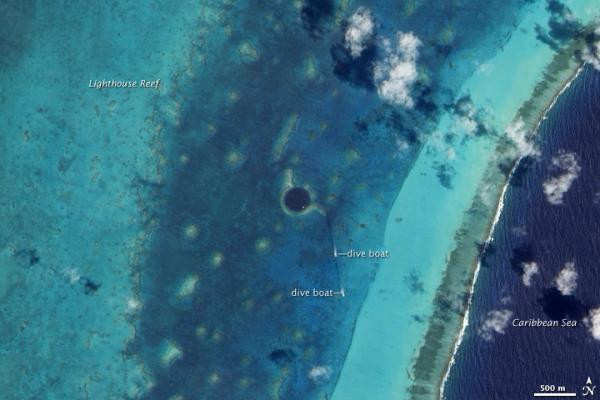
Climate Clues Found In Ancient Underwater Caves

Ice cores drilled from polar glaciers aren't the only place where scientists find clues about the Earth's past climate and by extension its potential future climate. Deep divers in the Bahamas are retrieving stalagmites from underwater caves to learn about the impact that ancient dust storms had on the planet's climate.
Scientists at the University of Miami collected samples of stalagmites that formed in underwater caves tens of thousands of years ago to study their chemical composition, an important indicator of the Earth's past climate .
Stalagmites are a type of cave formation created as water drips down from a cave's ceiling and onto its floor where it deposits minerals, particularly calcium carbonate, in cone-shaped spikes. Stalagmites are the formations that point up, while stalactites are the formations that hang from a cave's ceiling.
Great Blue Hole
The Miami team retrieved stalagmite samples from the Great Blue Hole in the Bahamas, an area whose past climate is somewhat of a mystery, said study team member Monica Arienzo, at a presentation of her work at the Society of Environmental Journalists conference held last month in Miami.
The Great Blue Hole is an underwater cavern ringed by corals. This vertical cave measures 1,000 feet (305 m) across and 412 feet (126 m) deep.
The stalagmite samples were brought back to the lab and drilled into so that scientists could analyze their makeup, which can tell scientists how wet or dry a period of time was. Specifically, the scientists looked at the carbon and oxygen isotopes present in the samples. Isotopes are different versions of a chemical element that have different numbers of neutrons in their atomic nuclei; the amount of a certain isotope present in a mineral can tell a lot about what environment that mineral formed in.
Sign up for the Live Science daily newsletter now
Get the world’s most fascinating discoveries delivered straight to your inbox.
Rapid shifts
The stalagmite samples from the Great Blue Hole showed three periods of rapid shifts from a wet to dry climate in the ancient Bahamas. These periods correlate with so-called Heinrich events in the North Atlantic, which are a well-studied phenomenon where very cold periods are followed by a rapid shift to a warmer climate. The three rapid shifts were found during the period from 13,500 to 31,500 years ago. The stalagmite data suggest that Heinrich events in the Bahamas are periods of extreme aridity followed by a much wetter climate.
Curiously, the team also found high levels of iron in the stalagmites during the Heinrich events. Iron shouldn't be there since there are no known nearby sources. The team's theory is that the iron was blown in during dust storms that originated in West Africa , Arienzo said.
If that turns out to be the case, African dust could have been an important force on the Earth's climate, much like carbon dioxide is today, Arienzo said.
You can follow OurAmazingPlanet staff writer Brett Israel on Twitter: @btisrael. Follow OurAmazingPlanet for the latest in Earth science and exploration news onTwitter @OAPlanet and on Facebook.










